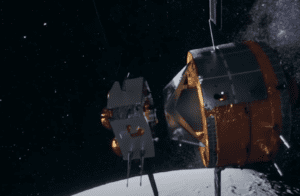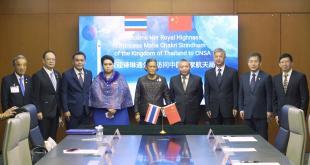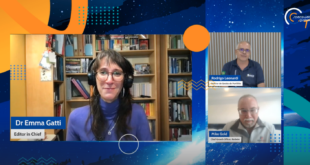by Blaine Curcio and Jean Deville
 As part of the partnership between SpaceWatch.Global and Orbital Gateway Consulting we have been granted permission to publish selected articles and texts. We are pleased to present “Dongfang Hour China Aerospace News Roundup 27 Dec – 2 January 2022 ”.
As part of the partnership between SpaceWatch.Global and Orbital Gateway Consulting we have been granted permission to publish selected articles and texts. We are pleased to present “Dongfang Hour China Aerospace News Roundup 27 Dec – 2 January 2022 ”.
Hello and welcome to the first episode of the Dongfang Hour China Space News Roundup, in 2022!
1) China confirms phase 4 lunar plans, in preparation of the ILRS
Jean’s Take
In a recent interview to Chinese national television, the deputy director of the CNSA Wu Yanhua revealed that the Phase 4 of China’s lunar exploration plans has been confirmed. For some context, China has performed 5 lunar missions to date, the Chang’e 1-5 missions, which were subdivided into 3 phases. Phase 1 was basically orbiting and mapping the Moon (and this was performed by Chang’e 1 and 2 in 2007 and 2010), phase 2 consisted in landing two rovers (this was done by Chang’e 3 and 4 in 2013 and 2018), and finally phase 3 with Chang’e 5, which performed a sample return mission at the end of 2020. The 4th phase, confirmed by Wu Yanhua, refers to the future Chang’e 6, 7 and 8 missions.
These missions were already discussed by China multiple times in recent years, so this doesn’t really come as a surprise. But this is a good opportunity to bring up these topics, so let’s just go over what we know at the moment about these 3 missions.
 All three missions will be taking place “in the next ten years”. The first mission will be Chang’e 7 rather than Chang’e 6. The spacecraft will head towards the lunar south pole, where are notably located a significant part of the Moon’s water resources under the form of ice. The Chang’e 7 mission will reportedly consist of an orbiter, a relay satellite, a lander, a moon hopper and a rover. Let’s break that down a little: The relay satellite is necessary due to the lack of direct line of sight between the lunar south pole and the Earth, and which is a technique that China already has some experience with (with the Queqiao relay satellite of the Chang’e 4 mission). The hopper will enable close-up exploration of the permanently shaded regions (PSR), which are areas, craters notably, of the Moon that always lie in darkness and are believed to have the largest reserves of ice. Chang’e 7’s hopper could have some similarity with the Nova-C mission planned by NASA, Intuitive Machines and the Arizona State University in 2022. According to a recent Weibo post by Dianfeng Gaodi, the Chinese hopper is designed by Shanghai Jiaotong University, and the small spacecraft will be able to take-off and land repeatedly, as well as displace itself on solid ground. The increased sophistication of the Chang’e 7 mission is worth noting, as it basically combines all of the technologies demonstrated in past missions (orbiter, lander, rover, relay) as well as some new ones (hopper).
All three missions will be taking place “in the next ten years”. The first mission will be Chang’e 7 rather than Chang’e 6. The spacecraft will head towards the lunar south pole, where are notably located a significant part of the Moon’s water resources under the form of ice. The Chang’e 7 mission will reportedly consist of an orbiter, a relay satellite, a lander, a moon hopper and a rover. Let’s break that down a little: The relay satellite is necessary due to the lack of direct line of sight between the lunar south pole and the Earth, and which is a technique that China already has some experience with (with the Queqiao relay satellite of the Chang’e 4 mission). The hopper will enable close-up exploration of the permanently shaded regions (PSR), which are areas, craters notably, of the Moon that always lie in darkness and are believed to have the largest reserves of ice. Chang’e 7’s hopper could have some similarity with the Nova-C mission planned by NASA, Intuitive Machines and the Arizona State University in 2022. According to a recent Weibo post by Dianfeng Gaodi, the Chinese hopper is designed by Shanghai Jiaotong University, and the small spacecraft will be able to take-off and land repeatedly, as well as displace itself on solid ground. The increased sophistication of the Chang’e 7 mission is worth noting, as it basically combines all of the technologies demonstrated in past missions (orbiter, lander, rover, relay) as well as some new ones (hopper).
According to a paper published at the 51st Lunar and Planetary Science Conference in 2020, Chang’e 7 would carry a total of 23 science payloads: 2 on the relay satellite, 5 on the orbiter, 7 on the lander, 4 on the rover, and 1 on the hopper. The mission is scheduled for launch in 2024.
Next comes Chang’e 6, which will take place after Chang’e 7. The mission was initially designed to be the back-up plan of the Chang’e 5 sample return mission. It will aim at returning samples from the South Pole–Aitken basin, one of the deepest lunar craters situated on the far side of the Moon. It will also reportedly carry instruments from foreign space agencies, including payloads from France, Italy, Sweden and Russia.
After Chang’e 7 and Chang’e 6, China will send Chang’e 8. It is unclear what Chang’e 8 will consist of, other than being a back-up mission of Chang’e 7. In Wu Yanhua’s interview to CCTV, he mentioned that the mission “will define a base model for the future ILRS station” (the ILRS being the sino-russian permanent lunar station planned for the 2030s). It could include the verification of key technologies such as in-situ resources utilization, 3D printing with lunar regolith, extraction of water from the ice present in the south pole, the generation of oxygen and hydrogen, …; Previous presentations made from Guo Linli, a chief engineer at CAST involved in lunar exploration and ISRU, had previously tentatively proposed a demonstrator to produce oxygen from lunar regolith, using a robotic arm to scoop up the lunar dust and an electrolytic furnace to turn the various metal oxides into metal components and oxygen.
Separately from the Chang’e lunar mission updates, Roscosmos announced that China and Russia will sign a new 5-year Space Cooperation Program agreement, covering the period 2023 to 2027, and which will include plans for setting up the sino-russian ILRS lunar station by 2035. And this agreement follows the previous 2018-2022 sino-russian space agreement.
Overall, it will be interesting to watch how China and Russia increasingly integrate their lunar missions. So far both countries have planned separately the Chang’e and Luna missions, but collaborations are bound to increase within the context of the ILRS.
documentary on Chinese lunar missions → 飞向月球,我的征途
2) Starlink and Chinese Space Station with a Close Encounter
Blaine’s Take
This week saw significant media coverage of a document published by the United Nations Office of Outer Space Affairs (UNOOSA) earlier in December, which saw China invoke Article V of the United Nations Outer Space Treaty stating that “States Parties to the Treaty shall immediately inform the other States Parties to the Treaty or the Secretary-General of the United Nations of any phenomena they discover in outer space, including the moon and other celestial bodies, which could constitute a danger to the life or health of astronauts.”
The document outlines two near-misses between the Chinese Space Station and Starlink satellites. In a document dated 6 December, the China National Space Administration (CNSA) states that “for safety reasons, the China Space Station implemented preventative collision avoidance control on 1 July and 21 October 2021, respectively”. The document from CNSA provides a number of details about the near incidents.
The Starlink-1095 satellite was initially orbiting around 555km, before dropping to around 382km in mid-2021. On 1 July 2021, what CNSA calls a “close encounter” occurred between the Chinese space station and Starlink-1095, with the CSS conducting an evasive maneuver to avoid the spacecraft. A similar situation occurred in October with the Starlink-2305 satellite, with CNSA noting that “the satellite was continuously maneuvering, the maneuver strategy was unknown and the orbital errors were hard to be assessed”.
At a press conference on Tuesday 28 December, Chinese Ministry of Foreign Affairs Spokesperson Zhao Lijian referred to 1967’s Outer Space Treaty, which calls for states to be responsible for national space activities, “whether carried out by governmental or non-governmental entities”. Zhao called upon the United States to “take immediate measures to prevent the recurrence of such incidents, and adopt a responsible attitude to safeguard the lives of astronauts in orbit and the safe and stable operation of space facilities”.
Moving forward, as one of the small number of countries planning to launch many thousands of satellites, China’s self-interests will involve a delicate balance. On one hand, China clearly needs to prioritize the safety of its Taikonauts, and thus will want to forcefully encourage Starlink to exercise caution, and possibly highlight the responsibility of the US to regulate SpaceX/Starlink in these scenarios.
On the other hand, future Chinese constellations will also pose similar risks to humans and infrastructure in space, and will require significant efforts to manage. Any standards that China works to impose on Starlink and SpaceX would, in theory, also apply to any future Chinese constellations.
In general, China tends to err on the side of conservative and long-term oriented, which would be a point in the “stricter regulations now, and also stricter regulations for Chinese constellations later” camp. China may also have an interest in not allowing Starlink to occupy such large amounts of low earth orbit, and thus may have an incentive to slow them down by pressuring for more caution, a strategy seen in other contexts by other companies with regard to Starlink, including the ITU and FCC.
Last point worth noting is that Elon Musk was, in my opinion, surprisingly dismissive of these concerns. Around the same time of the Chinese Space Station/Starlink firestorm, Head of ESA Josef Aschbacher cautioned that Musk and SpaceX were “making the rules” for commercial space. Musk was dismissive in a followup with the FT, stating that there is room for tens of billions of satellites in LEO.
While not explicitly stating “I disagree with China’s UN motion”, Musk did dismiss the broader concern. Moving forward, if there are future incidents between Chinese space assets and Starlink satellites, it will be interesting to see how outwardly critical, or at least dismissive, Musk can be of the Chinese leadership, in the same way that he has been dismissive of ESA’s concerns, or of the concerns of various other western organizations.
Jean’s Take
It’s interesting to note how threats of collision in orbit can get a bit political as well. We’ve seen China sternly rebuke the maneuvers of some Starlink satellites as Blaine has mentioned, but also remain silent in November for Russia’s ASAT test which created a lot of additional orbital debris. Similarly we’ve seen the US strongly condemn the Russian ASAT test, and the atmospheric reentry of large first stages of Chinese rockets, but while also having shot down one of their own satellites in 2008 in what was called Operation Burnt Frost.
This has been another episode of the Dongfang Hour China Space News Roundup. If you’ve made it this far, we thank you for your kind attention, and look forward to seeing you next time! Until then, don’t forget to follow us on YouTube, Twitter, or LinkedIn, or your local podcast source.
Blaine Curcio has spent the past 10 years at the intersection of China and the space sector. Blaine has spent most of the past decade in China, including Hong Kong, Shenzhen, and Beijing, working as a consultant and analyst covering the space/satcom sector for companies including Euroconsult and Orbital Gateway Consulting. When not talking about China space, Blaine can be found reading about economics/finance, exploring cities, and taking photos.
Jean Deville is a graduate from ISAE, where he studied aerospace engineering and specialized in fluid dynamics. A long-time aerospace enthusiast and China watcher, Jean was previously based in Toulouse and Shenzhen, and is currently working in the aviation industry between Paris and Shanghai. He also writes on a regular basis in the China Aerospace Blog. Hobbies include hiking, astrophotography, plane spotting, as well as a soft spot for Hakka food and (some) Ningxia wines.
 SpaceWatch.Global An independent perspective on space
SpaceWatch.Global An independent perspective on space




